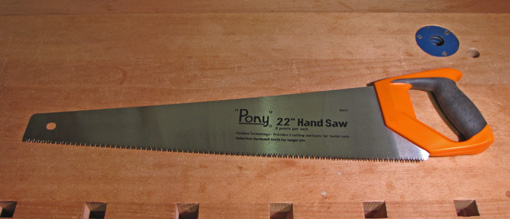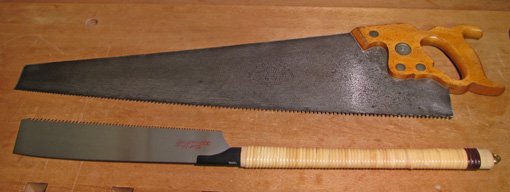For breaking down rough stock into the approximately dimensioned components of a project, I usually go to the bandsaw. Big boards usually need to be first crosscut into manageable pieces. For that job, I use the Pony crosscut saw that I praised in an earlier post and is pictured below. It’s not pretty but it sure gets the work done. Specs: 22″ 0.040″blade, 8 tpi Japanese-style hardened crosscut teeth that cut primarily on the push stroke, set 0.004″ each side. Best of all: $15.99, from Woodcraft, item #149039.

Despite my affection for the bandsaw, sometimes I prefer to rip with a handsaw. Maybe I don’t feel like setting up the bandsaw for a few short cuts, just prefer the relative quiet, or even prefer the relatively slower cutting to give me a chance to think.
I had been using my Japanese rip saw (top photo) for this but was never really happy with its performance in this job. The main drawback was that I could not put my weight into the cutting stroke. This saw does, however, shine for certain other cuts, especially small resawing and, as I mentioned in an earlier post, for cutting some large tenons. It can produce surprisingly clean surfaces for these type of cuts. It is also a handy saw for shorter ripping at the workbench. For these reasons, it certainly earns its place in the shop. Specs: Z brand 300 mm (11 3/4″), 0.027″ saw plate, 0.036″ kerf, rip teeth grading from 8 tpi at the handle end to 4 tpi at the far end. It is available from Hida Tool. Their item #D-ZS-#300 is the crosscut version for $38.90 but the rip replacement blade is item #D-ZS-S300R ($21.30) which perhaps you can ask them to install instead of the crosscut blade.
Now for big ripping, I wanted a full 26″ Western handsaw which I could put my weight into with the classic position of my left knee on the board. After some hunting around I bought a Disston D-7 (top photo) in great functional condition from Jim Bode. This is a straight back workhorse saw marked 5 ½ ppi (it measures more like 4 ½ ppi), vintage 1940-47. The saw plate is about 0.037″ near the slightly breasted tooth line and is, of course, taper ground as you go away from the teeth and toward the toe.
And it rips big time – just what I was looking for.
Next: the final installment in the series – reflections on a long saw journey



Thanks for these post I have been wanting to get some handsaws to further my progression into the handtool world. Your post have given me a lot of info. I always saw the japanese saws and with the cheap price when compared to the western saws I figured they were too cheap to work. How do they hold up? When you can buy 3 or more of them for the price of a good western saw it might be worth it.
Lamar,
Most replaceable blade Japanese saws have impulse-hardened teeth which wear very well. Also, I have not had teeth break even in very dense woods.
I know you haven’t said this, but I do want to make the point that one ought not infer from what I’ve written that everyone should get replaceable blade Japanese saws because they are cheaper. The eclectic bunch of saws that I use are what work for me. Japanese and Western saws are both good if matched to the task at hand and used with skill.
Good luck.
Rob
Hi Rob-
After reading your comments, I’m thinking about getting the “Law” DVD on Saw sharpening from TFWW and trying to sharpen some of my old craftsman saws. These saws are from the 60’s and 70’s so they may be reasonably worth the effort. Wouldn’t even think about sharpening the new junk they sell.
Thanks for getting me ambitious!
–Steve.
Thanks for the comment, Steve. Good luck with the sharpening.
Here’s a link to a good saw sharpening tutorial online:
http://www.vintagesaws.com/cgi-bin/frameset.cgi?left=main&right=/library/library.html
Rob
Rob,
Thank you for the review of the Pony crosscut. I have bought quite a few low priced crosscut saws when I see them in hardware stores, hoping for something capable. Most have disappointed me. This is the best and it has quenched (temporarily) my longing for a Wenzloff or Lie Neilsen. I do enjoy the ryoba/kataba/dozuki saws I have, but haven’t sought a rip in that genre. Today I ordered the z-saw from Hida Tool at your recommendation and look forward to using it in my box making. Thanks again.
Bruce
Bruce,
You’re welcome. Yea, the Pony crosscut is amazing. If they could ever make a taper ground sawplate that would make it perfect.
Keep in mind that the Z 300mm rip is a big-tooth saw, so I’m not sure how it will fit into box making work unless you have some small resawing in mind.
Good luck,
Rob
Rob,
That’s just what I plan. I have been making slant sided boxes for an artist friend who paints them with tendrils and other designs. I use a bandsaw to resaw 2 x 6’s at an angle, making mirror trapezoids before mitering. The boxes are 12-16 inches long. The rip kataba will be quiet and way less dusty. Thanks.
Bruce